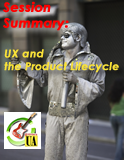![]() TechWhirl’s coverage of WritersUA 2012 is sponsored by Madcap Software. Find out more and download a trial copy of Flare 8.
TechWhirl’s coverage of WritersUA 2012 is sponsored by Madcap Software. Find out more and download a trial copy of Flare 8.
Presenter: Michael Hughes, IBM
 IBM’s Michael Hughes opened his first session of the WritersUA conference, Embedding User Experience in the Product Development Life Cycle, by provoking the audience members to show how they add value and get involved in the four stages of product development: Defining Requirements, Design and Validation, Development and Testing, and Deployment and Support.
IBM’s Michael Hughes opened his first session of the WritersUA conference, Embedding User Experience in the Product Development Life Cycle, by provoking the audience members to show how they add value and get involved in the four stages of product development: Defining Requirements, Design and Validation, Development and Testing, and Deployment and Support.
Hughes knows how challenging it can be to get involved and integrated with development teams. His model, which strays from the conventional business model of having User Assistance (UA) come into the process only in the usability testing phase, allows UA and User Experience (UX) to get involved much earlier in the cycle by defining requirements.
Hughes writes requirements as scenarios because they “really influence interesting conversations between stakeholders and developers.” Scenarios are written at the high level, but are very specific in identifying the key problem and solution.
This session really hit home for me —I just completed a three-week long requirements gathering and wireframing project for an upcoming software application. Like me, Hughes also swears by wireframing, because when words alone just don’t cut it, the wireframe provides a visual to enhance a requirement. And we both use a program called Balsamiq.
Tip: Avoid making your wireframe look like the actual product, people will argue about every last pixel.
Example: “The best thing about [Balsamiq] is that it looks like it was written on a napkin. It isn’t specific to pixels. It just represents button-ness.” – Hughes

Example of a Balsamiq Wireframe © Michael Hughes
Wireframing offers another key benefit— no matter how many iterations you go through during development, neither the requirement nor the contract changes.
Hughes also focuses on writing use cases to identify the “unhappy path,” such as what happens when the server goes down. “Agile designs the happy path nicely, but doesn’t investigate nasty scenarios that could come up for users,” said Hughes.
He identifies four spheres that influence requirements and offers some great practical tips on employing them:
1. Market Opportunities
Tip: Market research activities should be grounded in market value propositions.
Example: Engineering Productivity = $ of revenue/ # of engineers.
2. Technology Opportunities
Tip: Look for opportunities where new technologies can enhance the user experience.
Example: Zip code field auto-populating the city and State on a user input form.
3. Compliance
Tip: “Be interpreters and keepers of the law”
Example: We can take the burden off of the developer’s shoulders (and coincidentally off of our own) by volunteering to do the standards and compliance reviews ourselves.
4. User Needs – the “UX Sweet Spot”
Tip: Big user data has the most impact on both the product development and Help content.
Examples: Focus groups, contextual inquiries, usability testing, and investigating competitive products help companies “understand the expectations.”
Tip: When users make mistakes in using the product, they assume they’re stupid and should’ve known better. But in fact, someone designed it to be easier to do it wrong than to do it right. Find out why.
Example: Was the label wrong, or the button not big enough?
Development & Support
Tip: Design the UI to make it easier for users to communicate with tech support in the way that tech support prefers.
Example: If tech support prefers to chat with users rather than be called, make the chat window button easier to find than the phone number.
The bottom line: By using these methods to integrate yourself into the product development life cycle, you can add value to the project and therefore add value to yourself as an employee. Your employers will be impressed when you are stepping up and being proactive in applying user experience during early phases of development rather than being reactive and only doing usability testing after the product has been developed.

